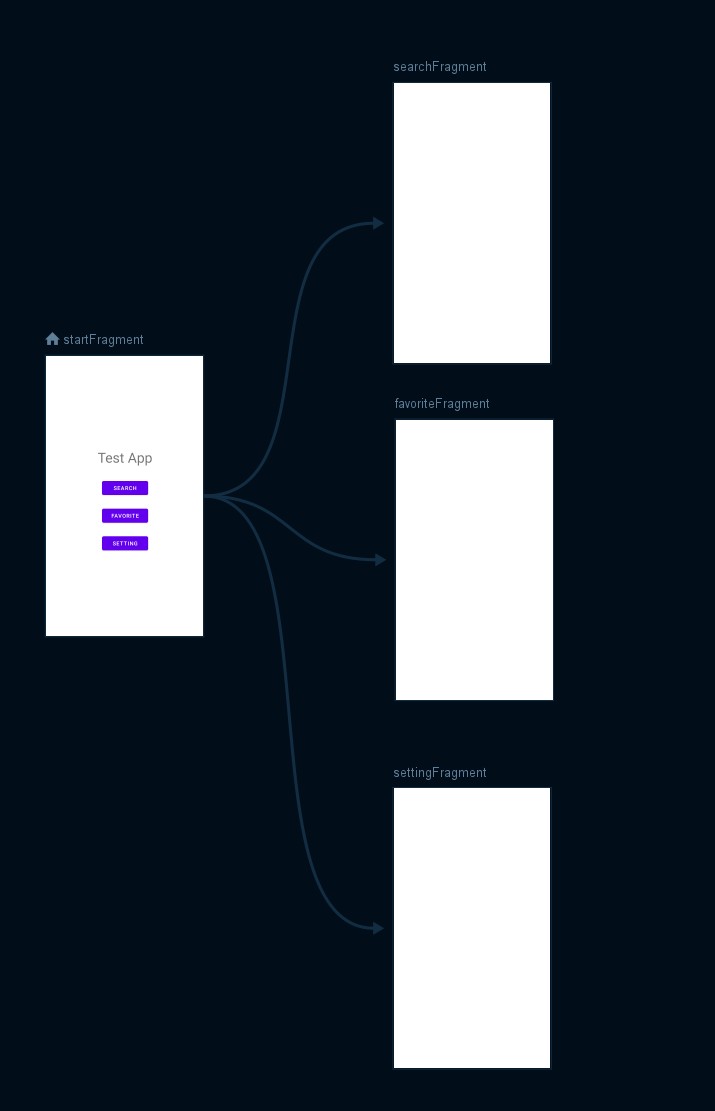なんか面白そうなやつがあったので試してみました。
備忘録的な感じです。
Navigationを実装してみる
とりあえず適当な新規プロジェクトを作成してFragmentを追加しました。
スタート画面レイアウト
<?xml version="1.0" encoding="utf-8"?>
<androidx.constraintlayout.widget.ConstraintLayout xmlns:android="http://schemas.android.com/apk/res/android"
xmlns:app="http://schemas.android.com/apk/res-auto"
android:layout_width="match_parent"
android:layout_height="match_parent">
<!--タイトル-->
<TextView
android:id="@+id/app_name"
android:layout_width="wrap_content"
android:layout_height="wrap_content"
android:text="@string/app_name"
android:textSize="@dimen/app_name_text"
app:layout_constraintBottom_toBottomOf="parent"
app:layout_constraintEnd_toEndOf="parent"
app:layout_constraintStart_toStartOf="parent"
app:layout_constraintTop_toTopOf="parent"
app:layout_constraintVertical_bias="0.35" />
<!--検索ボタン-->
<Button
android:id="@+id/start_search"
android:layout_width="120dp"
android:layout_height="wrap_content"
android:layout_marginTop="32dp"
android:text="@string/bt_start_search"
app:layout_constraintEnd_toEndOf="parent"
app:layout_constraintHorizontal_bias="0.5"
app:layout_constraintStart_toStartOf="parent"
app:layout_constraintTop_toBottomOf="@+id/app_name" />
<!--お気に入りボタン-->
<Button
android:id="@+id/start_favorite"
android:layout_width="120dp"
android:layout_height="wrap_content"
android:layout_marginTop="24dp"
android:text="@string/bt_start_favorite"
app:layout_constraintEnd_toEndOf="parent"
app:layout_constraintHorizontal_bias="0.5"
app:layout_constraintStart_toStartOf="parent"
app:layout_constraintTop_toBottomOf="@+id/start_search" />
<!--設定ボタン-->
<Button
android:id="@+id/start_setting"
android:layout_width="120dp"
android:layout_height="wrap_content"
android:layout_marginTop="24dp"
android:text="@string/bt_start_setting"
app:layout_constraintEnd_toEndOf="parent"
app:layout_constraintHorizontal_bias="0.5"
app:layout_constraintStart_toStartOf="parent"
app:layout_constraintTop_toBottomOf="@+id/start_favorite" />
</androidx.constraintlayout.widget.ConstraintLayout>
スタート画面から、ボタン押下で[検索画面/お気に入り画面/設定画面]に
それぞれ遷移できるようなアプリにします。
それではドキュメントに沿ってNavigationを実装していきます。
Step1 - 環境のセットアップ
Navigationに必要なものをアプリのbuild.gradleに追加します。syncを忘れずに。
ここはとりあえず入れるだけなので次に行きます。
dependencies{
//navigation implementation
def nav_version = "2.4.1"
implementation("androidx.navigation:navigation-fragment-ktx:$nav_version")
implementation("androidx.navigation:navigation-ui-ktx:$nav_version")
implementation("androidx.navigation:navigation-dynamic-features-fragment:$nav_version")
implementation("androidx.navigation:navigation-compose:$nav_version")
androidTestImplementation("androidx.navigation:navigation-testing:$nav_version")
}
Step2 - ナビゲーショングラフの作成
-
手順1
プロジェクト内にあるresディレクトリを右クリックし、
new → Android Resource Fileを選択 -
手順2
Resource TypeにNavigationを選択、適当なFile Nameを入れてOKボタンを押す
これでナビゲーショングラフが作成されます。
初めて作った際は、勝手にresディレクトリ内にnavigationディレクトリを作ってくれます。
また、作成されるとNavigation Editorが開きます。ここでナビゲーションを編集します。
step3 - Navigation Editorでディスティネーション追加
Navigation Editor画面から操作します。
-
手順1
Editorの画面をクリックして先ほど作成したfragment_start.xmlを追加 -
手順2
画面左上のNew Destinationボタンを押下してfragmentを追加または作成
今回はSearch,Favorite,Settingの三つを追加します -
手順3
fragment_startからドラッグし、三つのFragmentにそれぞれドロップしてパスを繋ぐ
<?xml version="1.0" encoding="utf-8"?>
<navigation xmlns:android="http://schemas.android.com/apk/res/android"
xmlns:app="http://schemas.android.com/apk/res-auto"
xmlns:tools="http://schemas.android.com/tools"
android:id="@+id/navi_start"
app:startDestination="@id/startFragment">
<fragment
android:id="@+id/startFragment"
android:name="com.example.lyricmemo.Fragment.StartFragment"
android:label="StartFragment"
tools:layout="@layout/fragment_start"
>
<action
android:id="@+id/action_startFragment_to_searchFragment"
app:destination="@id/searchFragment" />
<action
android:id="@+id/action_startFragment_to_favoriteFragment"
app:destination="@id/favoriteFragment" />
<action
android:id="@+id/action_startFragment_to_settingFragment"
app:destination="@id/settingFragment" />
</fragment>
<fragment
android:id="@+id/searchFragment"
android:name="com.example.lyricmemo.Fragment.SearchFragment"
android:label="SearchFragment"
tools:layout="@layout/fragment_search"
/>
<fragment
android:id="@+id/favoriteFragment"
android:name="com.example.lyricmemo.Fragment.FavoriteFragment"
android:label="FavoriteFragment"
tools:layout="@layout/fragment_favorite"
/>
<fragment
android:id="@+id/settingFragment"
android:name="com.example.lyricmemo.Fragment.SettingFragment"
android:label="SettingFragment"
tools:layout="@layout/fragment_setting"
/>
</navigation>
・要素内にはidと最初に表示させたいフラグメントを入れます。
・要素内には、遷移させたいフラグメントを設定しておきます。
・要素内にはそのフラグメントの遷移先と、その画面への遷移を示すidを設定しておきます。
注.フラグメントがPreview Unavailableと表示される場合
以下のように該当するFragmentにtoolsの記述を入れてください。
<fragment
android:id="@+id/startFragment"
android:name="com.example.testapp.Fragment.StartFragment"
android:label="StartFragment"
tools:layout="@layout/fragment_start"/><!--追加-->
-
ナビゲーション
アプリ内のディスティネーション間の移動 -
ディスティネーション
ユーザーがアプリ内で移動できる場所。アクションを通じて接続される -
ナビゲーショングラフ
全てのデスティネーションとアクションを格納するリソースファイル
また、全てのナビゲーションパスを示す
step3 - Navi Hostを追加する
ナビゲーションホストを埋め込んだフラグメントをxml形式で埋め込みます。
アプリ起動時に表示するメインアクティビティのレイアウトに、
以下のようにNavigationHostFragmentを埋め込んだフラグメントを書き入れました。
<?xml version="1.0" encoding="utf-8"?>
<androidx.constraintlayout.widget.ConstraintLayout xmlns:android="http://schemas.android.com/apk/res/android"
xmlns:app="http://schemas.android.com/apk/res-auto"
xmlns:tools="http://schemas.android.com/tools"
android:layout_width="match_parent"
android:layout_height="match_parent"
tools:context=".MainActivity">
<androidx.fragment.app.FragmentContainerView
android:id="@+id/nav_host_fragment"
android:name="androidx.navigation.fragment.NavHostFragment"
android:layout_width="0dp"
android:layout_height="0dp"
app:layout_constraintLeft_toLeftOf="parent"
app:layout_constraintRight_toRightOf="parent"
app:layout_constraintTop_toTopOf="parent"
app:layout_constraintBottom_toBottomOf="parent"
app:navGraph="@navigation/navi_graph" />
</androidx.constraintlayout.widget.ConstraintLayout>
・ナビゲーションホスト
Navigation Componentの中核を担う部分の一つ。
ディスティネーションを入れておくコンテナであり、
ユーザーが移動するとコンテナ内のディスティネーションも入れ替わる
step4 - ディスティネーションへの移動を実装する
ディスティネーションへの移動を実装するためには、
ナビゲーションコントローラを介して行う必要があります。
//Fragment.findNavController()
//View.findNavController()
//Activity.findNavController(viewId: Int)
これらのメソッドを使用して、コントローラを取得したら、
今度はFragmentで、ActionのIdを指定してディスティネーションへの移動を実装します。
class StartFragment : Fragment() {
override fun onCreateView(
inflater: LayoutInflater,
container: ViewGroup?,
savedInstanceState: Bundle?
): View? {
super.onCreateView(inflater, container, savedInstanceState)
val view = inflater.inflate(R.layout.fragment_start, container, false)
val btSearch = view.findViewById<Button>(R.id.start_search)
val btFavorite = view.findViewById<Button>(R.id.start_favorite)
val btSetting = view.findViewById<Button>(R.id.start_setting)
setDestination(btSearch, R.id.action_startFragment_to_searchFragment)
setDestination(btFavorite, R.id.action_startFragment_to_favoriteFragment)
setDestination(btSetting, R.id.action_startFragment_to_searchFragment)
return view;
}
private fun setDestination(button: Button, destId: Int){
button.setOnClickListener{
findNavController().navigate(destId);
}
}
}
すこし野暮ったかったので関数化しましたが、
このようにアクションを起こさせたいViewに対して、NavController.navigate(id)で
指定のidを入れてやることで、ディスティネーションへの遷移を実現できます。
・ナビゲーションコントローラ
NavHostを操作する際に使用するコントローラ
NavHost自体は直接操作しない
Step5 - 戻るボタンの処理を実装する
画面内のViewの操作は以上ですが、今度は戻るボタンでの処理を実装する必要があります。
デフォルトだと、そのままアプリが終了しますが今回は一つ前のフラグメントに
戻るように実装していきます。
戻るボタンの処理をOnBackPressDispatcheで変更します。
Navigationで一つ前のFragmentに戻る場合は、
findNavController().popBackStack()を使用します。
class SearchFragment : Fragment() {
override fun onCreate(savedInstanceState: Bundle?) {
super.onCreate(savedInstanceState)
//戻るボタンを押された際の処理
requireActivity().onBackPressedDispatcher.addCallback(this){
findNavController().popBackStack()
}
}
override fun onCreateView(
inflater: LayoutInflater,
container: ViewGroup?,
savedInstanceState: Bundle?
): View? {
super.onCreateView(inflater, container, savedInstanceState)
return inflater.inflate(R.layout.fragment_search, container, false)
}
}
ex - Safe Args を導入する
デスティネーション間の移動の際に使用する、Safe Args Gradle プラグインを導入します。
タイプセーフなナビゲーションを実現できます。
まず環境の設定から。
dependencies内に以下のように追加します。
buildscript {
dependencies {
//追加
def nav_version = "2.4.1"
classpath "androidx.navigation:navigation-safe-args-gradle-plugin:$nav_version"
}
}
plugins {
id 'com.android.application' version '7.1.2' apply false
id 'com.android.library' version '7.1.2' apply false
id 'org.jetbrains.kotlin.android' version '1.5.30' apply false
}
task clean(type: Delete) {
delete rootProject.buildDir
}
以下はkotlinに適したモジュールなので、Javaも使用している場合には
最後の.kotlinを抜いて使用してください。
plugins {
id 'com.android.application'
id 'org.jetbrains.kotlin.android'
//追加
id 'androidx.navigation.safeargs.kotlin'
}
※これ以外に、gradle.properties ファイルに android.useAndroidX=true が必要となるので設定しておきましょう。
以上でSafe Argsのセットアップが完了しました。
このSafe Argsを使用して生成されるクラスによって、ディスティネーションへの遷移時に
引数を渡したりすることができるようになります。この引数渡しに関してはまた別の機会に行います。
参考
